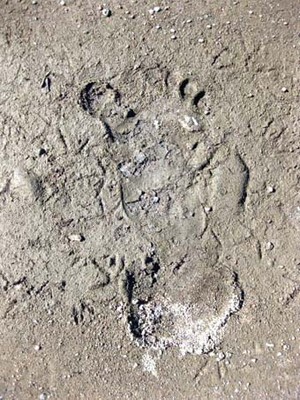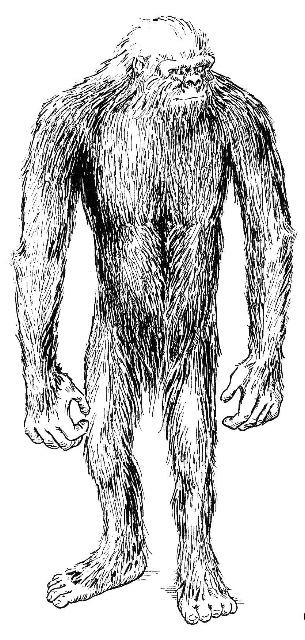New Ontario Sasquatch Track Find
Posted by: Loren Coleman on July 26th, 2008

In recent years, over 20 alleged encounters with Sasquatch have been recorded within the Northwestern Ontario region, including some accounts near Kenora at Coney Island.
Cobalt, Ontario, it will be recalled, is the site of the reports of the old Sasquatch with blond hair on its head called “Old Yellow Top” in 1906, 1923, 1946, and 1970.

“Old Yellow Top” drawn by Harry Trumbore in The Field Guide to Bigfoot and Other Mystery Primates.
Mecheny, a Marked Hominid, as drawn by artist Harry Trumbore in The Field Guide to Bigfoot and Other Mystery Primates.
The line between the Mecheny (the “Marked One”) and “Old Yellow Top” (of Cobalt, Ontario; pages 48-49) do tend to merge.
In an article, entitled “Sasquatch sighting has Grassy Narrows in a buzz,” by Garett Williams in the Kenora Miner and News, there is news of a footprint find. Also, the track photo has been published (top).
Randy Fobister’s pictures have been circulating through Grassy Narrows like gossip this week.
They are of a 15-inch long, six-toed, “big” footprint.
Driving to a blueberry picking site Tuesday, about an hour north of the reserve, Helen Pahpasay and her mother saw something they’ve never seen before.
“I seen a black, um … thing,” Pahpasay said. “It was tall and lanky and it was walking towards our way.
“I thought I was seeing things, so I didn’t say anything,” she said. “I looked over to my mom and she was rubbing her eyes.”
About eight feet tall. Slender. Black as night. Bigfoot was out for a walk.
“It was just walking casually,” she said. “I know it wasn’t an animal, cause it was upright. It was human like, like the way we walk.”
Scared, the women drove back to their community. Pahpasay told her family, who turned her right around for the hunt.
What they found is six-toed footprints somewhere in the woods, near a beaver pond.
It appears it leaped over a dam, into the pond, Fobister said.
“Sort of like one big-foot jump.”
Fobister made a cast of the print that afternoon and plans to send it out to be analyzed.
The story of the creature isn’t new to the community.
Tales circulated through history speak of a tall, creature-like thing, screaming loudly in the same area.
No one was ever brave enough to try to confront it in the past, but Fobister was ready.
“We were just excited,” he said. “I kept hearing about this thing, I’ve been hearing about it since I was a kid, so when I got the chance close by here I jumped right on it.”
About Loren Coleman
Loren Coleman is one of the world’s leading cryptozoologists, some say “the” leading living cryptozoologist. Certainly, he is acknowledged as the current living American researcher and writer who has most popularized cryptozoology in the late 20th and early 21st centuries.
Starting his fieldwork and investigations in 1960, after traveling and trekking extensively in pursuit of cryptozoological mysteries, Coleman began writing to share his experiences in 1969. An honorary member of Ivan T. Sanderson’s Society for the Investigation of the Unexplained in the 1970s, Coleman has been bestowed with similar honorary memberships of the North Idaho College Cryptozoology Club in 1983, and in subsequent years, that of the British Columbia Scientific Cryptozoology Club, CryptoSafari International, and other international organizations. He was also a Life Member and Benefactor of the International Society of Cryptozoology (now-defunct).
Loren Coleman’s daily blog, as a member of the Cryptomundo Team, served as an ongoing avenue of communication for the ever-growing body of cryptozoo news from 2005 through 2013. He returned as an infrequent contributor beginning Halloween week of 2015.
Coleman is the founder in 2003, and current director of the International Cryptozoology Museum in Portland, Maine.










Around my neck of the woods. How exciting for us Canadians!
I’m a little jealous. Six toes?? Are their numbers dwindling so much that they are inbreeding? I am hoping there are more prints than just the one shown above. Of which, I was kinda concerned about the heel. It looks flubbed up. Like someone took a cast, set it in the soft dirt and then had to adjust it. Good luck. If we are lucky we will get a live one. Some one get a primate vet for one of Canada’s zoos in the area. I understand that no one has tranquilized a big foot before, but I figure a primate vet (specifically the large ape keeper) should know approximately how much an 8 ft primate should be able to handle.
I lived in the NWO area for 5 years up until moving a couple months ago. There certainly were plenty of bigfoot stories, and even a roadside statue of one near Vermilion Bay, ON on the TCH east of Kenora.
Very cool find!
Interesting that they depict the creature as slender, when there’s this popular conception that Bigfoots are always massive and robust.
Interesting report and I hope there are more. Intersting implicatons as well.
Considering red_pill_junkie’s observation and another poster on a recent blog about the differences in behaviour pattern by region would it be reasonable to assume Bigfoot are different in different regions? If so, wouldn’t this indicate isolated (from other bigfoot) breeding populations? Different species or sub-species?